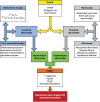Brugada Syndrome: Clinical Features, Risk Stratification, and Management
- PMID: 33014301
- PMCID: PMC7507903
- DOI: 10.4103/HEARTVIEWS.HEARTVIEWS_44_20
Brugada Syndrome: Clinical Features, Risk Stratification, and Management
Abstract
In 1992, the Brugada brothers published a patient series of aborted sudden death, who were successfully resuscitated from ventricular fibrillation (VF). These patients had a characteristic coved ST-segment elevation in the right precordial leads on their 12-lead electrocardiogram with no apparent structural heart abnormality. This disease was referred to as "right bundle branch block, persistent ST-segment elevation, and sudden death syndrome." The term Brugada syndrome (BrS) was first coined for this new arrhythmogenic entity in 1996. BrS is more prevalent in Southeast Asian ethnic groups and was considered a familial disease due to the presence of syncope and/or sudden deaths in several members of the same family, however, the genetic alteration was only noted in 1998. The genetic characterization of BrS has proven to be challenging. The most common and well-established BrS genotype involves loss-of-function mutations in the SCN5A gene, but only represents between 15% and 30% of the diagnosed patients. Patients with BrS can present with a range of symptoms which can include syncope, seizures, and nocturnal agonal breathing due to polymorphic ventricular tachycardia or VF. If these arrhythmias are sustained, sudden cardiac death may result. Despite the significant progress on the understanding of BrS over the last two decades, there remain a number of uncertainties and challenges; we present an update review on the subject.
Keywords: Brugada syndrome; electrical storm; epicardial ablation; polymorphic ventricular tachycardia; right ventricular outflow tract ablation; sudden cardiac death; ventricular fibrillation.
Copyright: © 2020 Heart Views.
Conflict of interest statement
There are no conflicts of interest.
Figures




Similar articles
-
[Doubts of the cardiologist regarding an electrocardiogram presenting QRS V1-V2 complexes with positive terminal wave and ST segment elevation. Consensus Conference promoted by the Italian Cardiology Society].G Ital Cardiol (Rome). 2010 Nov;11(11 Suppl 2):3S-22S. G Ital Cardiol (Rome). 2010. PMID: 21361048 Italian.
-
Role of Catheter Ablation for Ventricular Arrhythmias in Brugada Syndrome.Curr Cardiol Rep. 2021 Apr 24;23(5):54. doi: 10.1007/s11886-021-01479-2. Curr Cardiol Rep. 2021. PMID: 33893882 Free PMC article. Review.
-
Electrocardiographic methods for diagnosis and risk stratification in the Brugada syndrome.J Saudi Heart Assoc. 2015 Apr;27(2):96-108. doi: 10.1016/j.jsha.2014.06.004. Epub 2014 Jul 3. J Saudi Heart Assoc. 2015. PMID: 25870503 Free PMC article. Review.
-
Brugada syndrome: A general cardiologist's perspective.Eur J Intern Med. 2017 Oct;44:19-27. doi: 10.1016/j.ejim.2017.06.019. Epub 2017 Jun 20. Eur J Intern Med. 2017. PMID: 28645806 Review.
-
Brugada Syndrome: Progress in Diagnosis and Management.Arrhythm Electrophysiol Rev. 2019 Mar;8(1):13-18. doi: 10.15420/aer.2018.73.2. Arrhythm Electrophysiol Rev. 2019. PMID: 30918662 Free PMC article. Review.
Cited by
-
Ventricular Tachycardia in an Elderly Male With Brugada Syndrome.J Investig Med High Impact Case Rep. 2023 Jan-Dec;11:23247096231201005. doi: 10.1177/23247096231201005. J Investig Med High Impact Case Rep. 2023. PMID: 37737574 Free PMC article.
-
Ethnic and racial differences in Asian populations with ion channelopathies associated with sudden cardiac death.Front Cardiovasc Med. 2023 Aug 4;10:1253479. doi: 10.3389/fcvm.2023.1253479. eCollection 2023. Front Cardiovasc Med. 2023. PMID: 37600027 Free PMC article. Review.
-
Novel SCN5A and GPD1L Variants Identified in Two Unrelated Han-Chinese Patients With Clinically Suspected Brugada Syndrome.Front Cardiovasc Med. 2021 Dec 8;8:758903. doi: 10.3389/fcvm.2021.758903. eCollection 2021. Front Cardiovasc Med. 2021. PMID: 34957250 Free PMC article.
References
-
- Guazon M. Algunas Notas Sobre Bangungut. Filipina Med Farm. 1917;8:437–42.
-
- Brugada P, Brugada J. Right bundle branch block, persistent ST segment elevation and sudden cardiac death: A distinct clinical and electrocardiographic syndrome. A multicenter report. J Am Coll Cardiol. 1992;20:1391–6. - PubMed
-
- Miyazaki T, Mitamura H, Miyoshi S, Soejima K, Aizawa Y, Ogawa S. Autonomic and antiarrhythmic drug modulation of ST segment elevation in patients with Brugada syndrome. J Am Coll Cardiol. 1996;27:1061–70. - PubMed
-
- Nademanee K, Veerakul G, Nimmannit S, Chaowakul V, Bhuripanyo K, Likittanasombat K, et al. Arrhythmogenic marker for the sudden unexplained death syndrome in Thai men. Circulation. 1997;96:2595–600. - PubMed
-
- Chen Q, Kirsch GE, Zhang D, Brugada R, Brugada J, Brugada P, et al. Genetic basis and molecular mechanism for idiopathic ventricular fibrillation. Nature. 1998;392:293–6. - PubMed
Publication types
LinkOut - more resources
Full Text Sources
Miscellaneous
